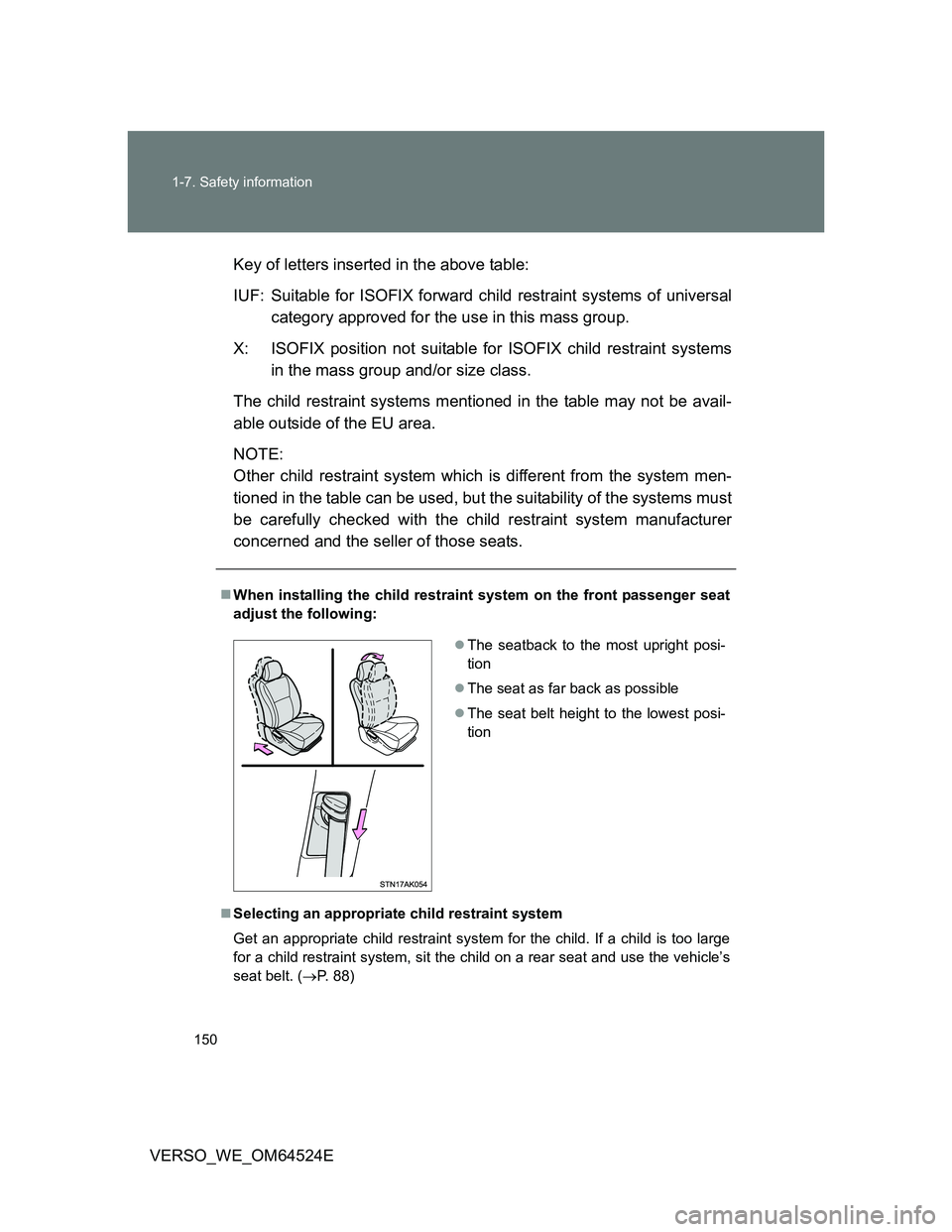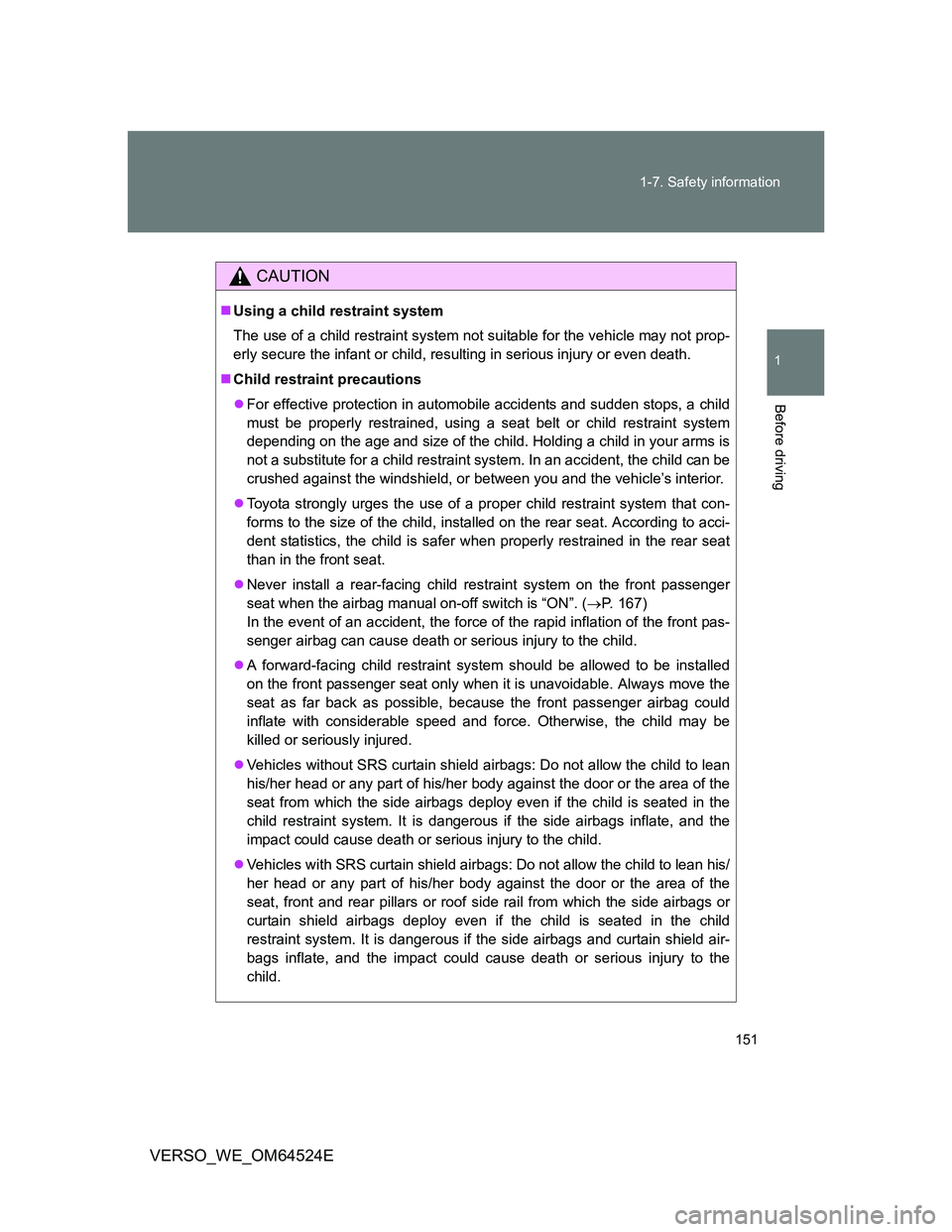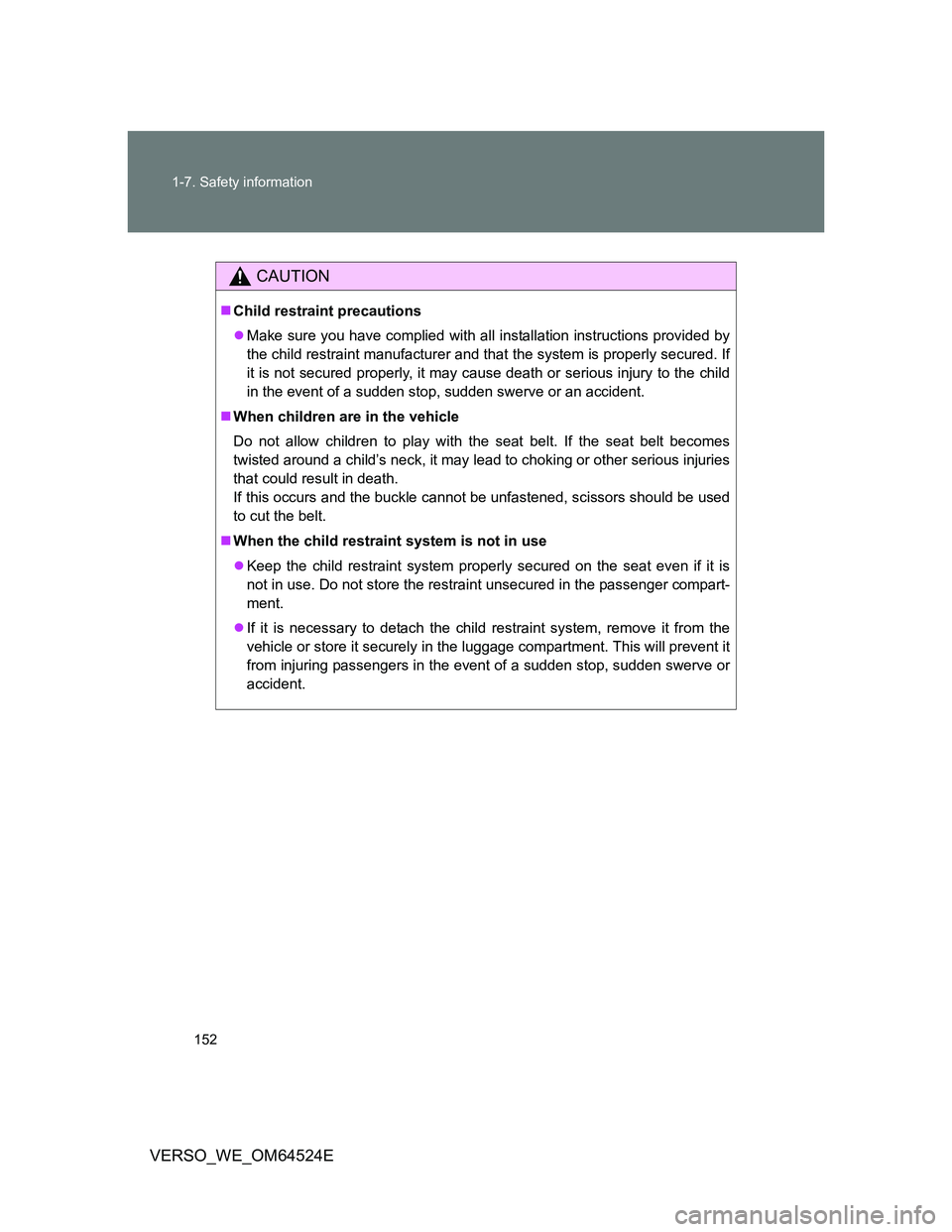Page 149 of 588
149 1-7. Safety information
1
Before driving
VERSO_WE_OM64524E
Child restraint system suitability for various seating positions
(with ISOFIX rigid anchor)
Provided information in the table shows your child restraint system
suitability for various seating positions.
Mass group Size class FixtureVehicle ISOFIX
position
Outside second
seats
CarrycotF
ISO/L1X
G
ISO/L2X
0
Up to 10 kg (22 lb.)
(0 - 9 months)E
ISO/R1X
0
+
Up to 13 kg (28 lb.)
(0 - 2 years)E
ISO/R1X
D
ISO/R2X
C
ISO/R3X
I
9 to 18 kg
(20 to 39 lb.)
(9 months - 4 years)D
ISO/R2X
C
ISO/R3X
B
ISO/F2IUF
B1
ISO/F2XIUF
A
ISO/F3IUF
II
15 to 25 kg
(34 to 55 lb.)
(4 years - 7 years)–– X
III
22 to 36 kg
(49 to 79 lb.)
(6 years - 12 years)–– X
Page 150 of 588

150 1-7. Safety information
VERSO_WE_OM64524EKey of letters inserted in the above table:
IUF: Suitable for ISOFIX forward child restraint systems of universal
category approved for the use in this mass group.
X: ISOFIX position not suitable for ISOFIX child restraint systems
in the mass group and/or size class.
The child restraint systems mentioned in the table may not be avail-
able outside of the EU area.
NOTE:
Other child restraint system which is different from the system men-
tioned in the table can be used, but the suitability of the systems must
be carefully checked with the child restraint system manufacturer
concerned and the seller of those seats.
When installing the child restraint system on the front passenger seat
adjust the following:
Selecting an appropriate child restraint system
Get an appropriate child restraint system for the child. If a child is too large
for a child restraint system, sit the child on a rear seat and use the vehicle’s
seat belt. (P. 88)
The seatback to the most upright posi-
tion
The seat as far back as possible
The seat belt height to the lowest posi-
tion
Page 151 of 588

151 1-7. Safety information
1
Before driving
VERSO_WE_OM64524E
CAUTION
Using a child restraint system
The use of a child restraint system not suitable for the vehicle may not prop-
erly secure the infant or child, resulting in serious injury or even death.
Child restraint precautions
For effective protection in automobile accidents and sudden stops, a child
must be properly restrained, using a seat belt or child restraint system
depending on the age and size of the child. Holding a child in your arms is
not a substitute for a child restraint system. In an accident, the child can be
crushed against the windshield, or between you and the vehicle’s interior.
Toyota strongly urges the use of a proper child restraint system that con-
forms to the size of the child, installed on the rear seat. According to acci-
dent statistics, the child is safer when properly restrained in the rear seat
than in the front seat.
Never install a rear-facing child restraint system on the front passenger
seat when the airbag manual on-off switch is “ON”. (P. 167)
In the event of an accident, the force of the rapid inflation of the front pas-
senger airbag can cause death or serious injury to the child.
A forward-facing child restraint system should be allowed to be installed
on the front passenger seat only when it is unavoidable. Always move the
seat as far back as possible, because the front passenger airbag could
inflate with considerable speed and force. Otherwise, the child may be
killed or seriously injured.
Vehicles without SRS curtain shield airbags: Do not allow the child to lean
his/her head or any part of his/her body against the door or the area of the
seat from which the side airbags deploy even if the child is seated in the
child restraint system. It is dangerous if the side airbags inflate, and the
impact could cause death or serious injury to the child.
Vehicles with SRS curtain shield airbags: Do not allow the child to lean his/
her head or any part of his/her body against the door or the area of the
seat, front and rear pillars or roof side rail from which the side airbags or
curtain shield airbags deploy even if the child is seated in the child
restraint system. It is dangerous if the side airbags and curtain shield air-
bags inflate, and the impact could cause death or serious injury to the
child.
Page 152 of 588

152 1-7. Safety information
VERSO_WE_OM64524E
CAUTION
Child restraint precautions
Make sure you have complied with all installation instructions provided by
the child restraint manufacturer and that the system is properly secured. If
it is not secured properly, it may cause death or serious injury to the child
in the event of a sudden stop, sudden swerve or an accident.
When children are in the vehicle
Do not allow children to play with the seat belt. If the seat belt becomes
twisted around a child’s neck, it may lead to choking or other serious injuries
that could result in death.
If this occurs and the buckle cannot be unfastened, scissors should be used
to cut the belt.
When the child restraint system is not in use
Keep the child restraint system properly secured on the seat even if it is
not in use. Do not store the restraint unsecured in the passenger compart-
ment.
If it is necessary to detach the child restraint system, remove it from the
vehicle or store it securely in the luggage compartment. This will prevent it
from injuring passengers in the event of a sudden stop, sudden swerve or
accident.
Page 153 of 588
153
1
1-7. Safety information
Before driving
VERSO_WE_OM64524E
Installing child restraints
Follow the child restraint system manufacturer’s instructions. Firmly
secure the child restraints using a seat belt or a ISOFIX rigid anchor
(ISOFIX child restraint system). Attach the top strap when installing
a child restraint system.
Seat belts (An ELR belt
requires a locking clip.)
Second seat: ISOFIX rigid
anchor (ISOFIX child restraint
system)
These exclusive fixing bars are
provided for the outside sec-
ond seats. (Tags displaying the
location of the anchors are
attached to the seats.)
Second seat: Anchor bracket
(for top strap)
Anchor brackets are provided
for outside second seats.
Page 154 of 588
154 1-7. Safety information
VERSO_WE_OM64524E
Installing child restraints using a seat belt
Rear-facing Baby seat/child seat
Second seats
Adjust the seat as far back as
possible.
Fold the seatback while pulling
the seatback angle adjustment
lever. Return the seatback and
secure it at the 1st lock position
(most upright position). (P. 7 9 )
Third seats (vehicles with third seats)
Adjust the second seat forward
so that it does not interfere with
the child restraint system.
Fold the seatback while pulling
the seatback angle adjustment
strap. Return the seatback and
secure it at the 1st lock position
(most upright position). (P. 8 0 )
Place the child seat on the rear
seat facing the rear of the vehi-
cle.
Page 155 of 588
155 1-7. Safety information
1
Before driving
VERSO_WE_OM64524ERun the seat belt through the
child seat and insert the plate
into the buckle. Make sure that
the belt is not twisted.
Install a locking clip near the tab
of the lap and shoulder belt by
inserting the lap and shoulder
webbing through the recesses of
the locking clip. Buckle the belt
again. If the belt has any slack,
release the buckle and reinstall
the locking clip.
If your child restraint system does
not provide a locking clip, you can
purchase one at any authorized
Toyota dealer or repairer, or
another duly qualified and
equipped professional.
Locking clip for child restraint sys-
tem (Part No. 73119-22010)
Page 156 of 588
156 1-7. Safety information
VERSO_WE_OM64524EForward-facing Child seat
Second seats
Adjust the seat as far back as
possible.
Fold the seatback while pulling
the seatback angle adjustment
lever. Return the seatback and
secure it at the 1st lock position
(most upright position). (P. 7 9 )
Third seats (vehicles with third seats)
Adjust the second seat forward
so that it does not interfere with
the child restraint system.
Fold the seatback while pulling
the seatback angle adjustment
strap. Return the seatback and
secure it at the 1st lock position
(most upright position). (P. 8 0 )
Place the child seat on the seat
facing the front of the vehicle.